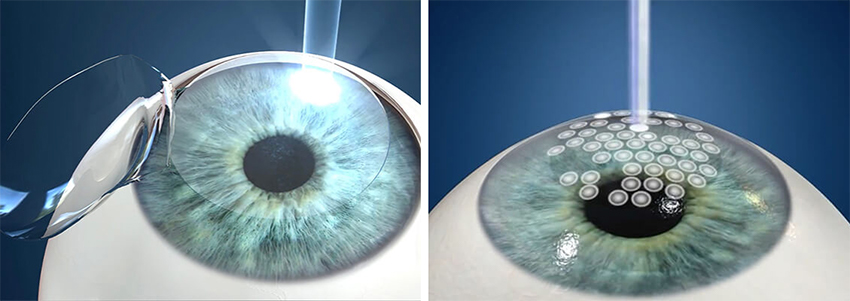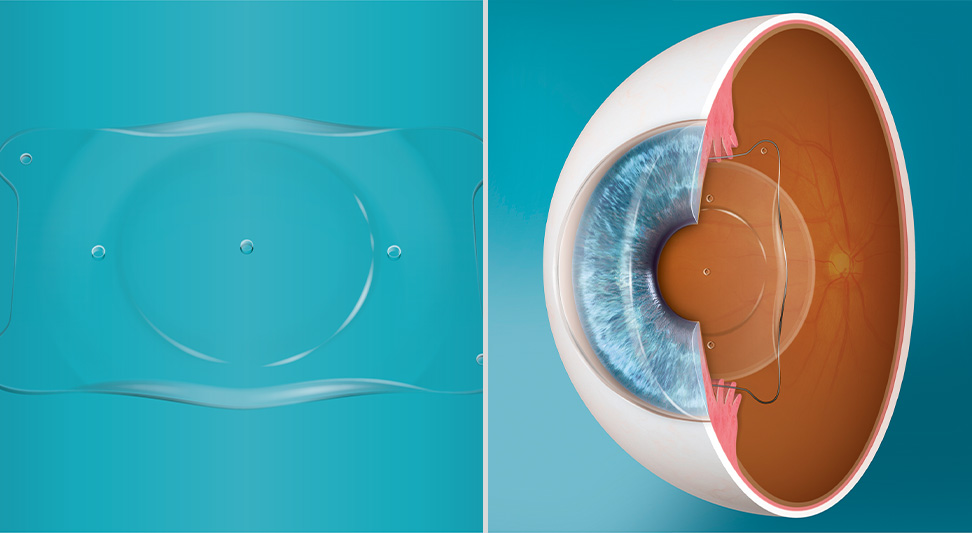Refractive correction surgeries have evolved tremendously over the years, offering patients a variety of options to improve their eyesight. Two of the most popular and advanced procedures are LASIK (Laser-Assisted In Situ Keratomileusis) and EVO ICL (Implantable Collamer Lens). While they both ultimately correct vision, they are completely different procedures that have different histories and development. Let’s compare the ideal candidates for each procedure, discuss the risks and side effects, and outline the recovery periods.
Development History of LASIK
LASIK has been a game-changer in the field of vision correction. The procedure was first developed in the late 1980s and received approval from the FDA in the mid-1990s. It quickly became popular due to its effectiveness and relatively quick recovery time. The technique involves creating a thin flap on the cornea using a microkeratome or femtosecond laser. This flap is then lifted, and an excimer laser reshapes the corneal tissue underneath to correct vision problems such as myopia (nearsightedness), hyperopia (farsightedness), and astigmatism.
Milestones in LASIK Development
- Late 1980s: Initial development of the LASIK procedure.
- 1990: First successful LASIK surgeries performed.
- 1995: FDA approval for LASIK in the United States.
- 2000s: Introduction of femtosecond lasers for creating the corneal flap, improving safety and precision.
Development History of EVO ICL
EVO ICL represents a newer approach to vision correction. The Implantable Collamer Lens (ICL) was developed in the early 1990s as an alternative to LASIK, particularly for patients who were not suitable candidates for laser-based procedures. The EVO ICL was developed and released more recently as is a biocompatible lens that is implanted behind the iris and in front of the natural lens, providing clear vision without altering the corneal structure. This procedure was designed to correct myopia and astigmatism while preserving the natural integrity of the eye.
Milestones in EVO ICL Development
- Early 1990s: Initial development of the ICL procedure.
- 1997: FDA approval for the first generation of ICLs.
- 2005: Introduction of the Visian ICL, an improved version of the original lens.
- 2018: Approval and introduction of the EVO ICL, featuring advancements in lens design and biocompatibility.
Ideal Candidates for LASIK
Age and Vision Stability
- Age: Patients should be at least 18 years old.
- Stable Vision: Vision should be stable for at least one year before the surgery.
Eye Health and Corneal Thickness
- Corneal Thickness: Adequate corneal thickness is essential for creating the flap.
- Overall Eye Health: Patients should not have any active eye infections, severe dry eye, or other significant eye conditions.
Types of Vision Problems
- Myopia: Suitable for patients with mild to moderate nearsightedness.
- Hyperopia: Effective for patients with mild to moderate farsightedness.
- Astigmatism: Can correct mild to moderate astigmatism.
Ideal Candidates for EVO ICL
Age and Vision Stability
- Age: Patients should be between 21 and 45 years old.
- Stable Vision: Vision should be stable for at least one year before the procedure.
Eye Health and Corneal Structure
- Corneal Thickness: Suitable for patients with thinner corneas who may not be candidates for LASIK.
- Overall Eye Health: No active eye infections or severe dry eye. Suitable for patients with a healthy anterior chamber depth and endothelial cell density.
Types of Vision Problems
- Myopia: Best for patients with moderate to severe nearsightedness.
- Astigmatism: Effective for patients with astigmatism.

Risks and Side Effects of LASIK
Common Risks and Side Effects
- Dry Eyes: Temporary or chronic dry eye symptoms can occur.
- Flap Complications: Issues with the corneal flap, such as dislocation or incomplete healing, may arise.
- Visual Disturbances: Glare, halos, or double vision, especially at night.
- Under- or Over-Correction: Some patients may still need glasses or contacts for certain activities.
Less Common Risks
- Infection: Although rare, infections can occur post-surgery.
- Epithelial Ingrowth: Cells from the outer layer of the cornea can grow under the flap.
- Regression: Some patients may experience a gradual return of vision problems over time.
Risks and Side Effects of EVO ICL
Common Risks and Side Effects
- Infection: Risk of infection, as with any surgical procedure.
- Increased Intraocular Pressure: Temporary increase in eye pressure post-surgery.
- Glare and Halos: Some patients may experience glare and halos around lights.
- Lens Dislocation: The implanted lens can become dislocated, requiring repositioning.
Less Common Risks
- Cataracts: The procedure may slightly increase the risk of developing cataracts.
- Endothelial Cell Loss: Potential for gradual loss of endothelial cells, which line the inner surface of the cornea.
- Retinal Detachment: Slightly increased risk compared to other refractive surgeries.
Recovery Period for LASIK
Initial Recovery
- First 24-48 Hours: Most patients experience significantly improved vision within 24-48 hours post-surgery.
- Restrictions: Patients are advised to avoid strenuous activities, swimming, and eye makeup for the first week.
Full Recovery
- Several Weeks to a Few Months: It can take several weeks to a few months for vision to stabilize completely and for minor side effects like dry eyes to resolve.
Recovery Period for EVO ICL
Initial Recovery
- First Few Days: Most patients experience improved vision within a few days post-surgery.
- Restrictions: Patients should avoid rubbing their eyes, strenuous activities, and swimming for the first week.
Full Recovery
- Several Weeks: It can take several weeks for vision to stabilize completely and for any initial side effects to subside.
Comanagement Between Refractive Surgeons and Optometrists
Pre-Operative Care
Optometrists play a crucial role in the initial evaluation of patients considering refractive surgery. They perform comprehensive eye exams, assess the patient’s suitability for LASIK or EVO ICL, and discuss the potential risks and benefits of each procedure. This collaboration ensures that patients are well-informed and receive the most appropriate treatment for their vision needs.
Post-Operative Care
After surgery, co-managing optometrists monitor the patient’s recovery, manage any complications, and provide follow-up care. They work closely with refractive surgeons to ensure that the patient’s healing process is on track and that their vision is improving as expected. This co-management approach ensures continuity of care and optimal outcomes for the patient.
Importance of Regular Check-Ups
Annual check-ups with both the optometrist are highly recommended and essential to monitor the long-term success of the surgery. These visits help detect any potential issues early on and ensure that the patient’s vision remains stable and clear.
EVO ICL vs. LASIK Surgery
Both LASIK and EVO ICL offer effective solutions for vision correction, each with its own set of advantages and considerations. LASIK is a well-established procedure with a shorter recovery period, making it a popular choice for many patients. EVO ICL, on the other hand, provides an excellent option for those with moderate to severe myopia and thinner corneas, offering a reversible and biocompatible alternative.
When considering refractive surgery, it’s essential to consult with an experienced optometrist and refractive surgeon to determine the best option based on individual needs and eye health. Understanding the differences between LASIK and EVO ICL, including the development history, ideal candidates, risks, side effects, and recovery periods, can help patients make informed decisions about their vision correction journey. Through co-management and regular check-ups, patients can achieve optimal visual outcomes and enjoy the benefits of clear, sharp vision.
At Optical Illusions: An Optometric Practice, we are committed to providing exceptional eye care. Our experienced optometrists use state-of-the-art technology to diagnose and treat through our medical eye exams and partner with the best eye surgeons in the area. Don’t wait until symptoms get worse—schedule your eye exam today and take proactive steps towards safeguarding your vision and health. Contact our team to schedule your appointment at 1 of our 4 conveniently located offices.



